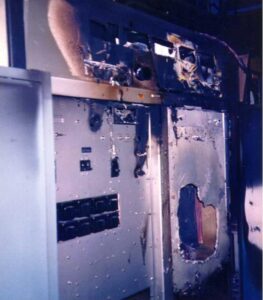RCA Broadcast Transmitter Defects The History of Just One of Many

[August 2023] In general, RCA had a good reputation for well-built transmitters. Even today, if you look at the immaculate wiring inside the transmitters, there is some admiration for the folks that did the work. But not all the transmitters were trouble-free.
Hans Bott designed some of the early RCA FM transmitters and for their day, they were quite reliable.
However, when RCA moved its Broadcast group to Meadowlands, Pennsylvania, they lost their most significant transmitter designer. Hans went to Gates Radio, now GatesAir and Harris Broadcast Products, and headed up their new television transmitter division. Many years later, I worked for Hans as he came out of retirement to become VP of Engineering at McMartin Industries in Omaha, Nebraska.
Hence, I am quite familiar with “both sides” of the RCA transmitter quagmire.
A GOOD DESIGN OVERDONE
In the early ‘60s, RCA took the basic 10 kW RF final amplifier design and added a solid-state power supply, a new vacuum-tube exciter, the BTE-10C, a new power amplifier tube, and a larger blower.
The result was the BTF-20E FM transmitter, which was set out to serve the 20 kW transmitter market.
It had several problems, all of which I will not detail here.
A REAL FLAMETHROWER!

The major problem was that once an arc started in the PA Box, it would track across a highly-flammable Rexolite plastic shelf and start a fire.
Then, fanned by the high-velocity air from the blower, the fire would cause molten aluminum to run out of the transmitter and start more fires.
Occasionally, discussions about the 20E pop up on different Internet mailing lists. The content always ended up all about its fires.
This transmitter eventually earned the unflattering nicknames of “Flame Thrower” and “Fireball.”
HOW THE 20E GOT ME
I worked for RCA Service Company out of the South Philadelphia office then.
Although very young (in my early twenties), I enjoyed installing TV transmitters, rebuilding old ones, and performing proof-of-performance measurements for RCA equipment, including TV transmitters and antennas. I loved the job because I visited many major cities and worked with some outstanding people in the broadcast industry.
Since I spent most of my time in the field, the company paid my living expenses, so I could save money and even purchase my first new automobile. Life was good!
BUT THEN…
An emergency occurred. A fire had destroyed some stations that installed new RCA BTF20E FM transmitters.
To correct the problem, RCA developed a new “retrofit kit” to install into the remaining FM transmitters. This was to prevent future fires. I was sent to Meadowlands to learn how to install these kits in the field. David Sauer was the engineer in charge. He explained that once an arc had started within the PA box, no overload condition was detected because the PA current could actually drop.
The power that used to go out to the antenna would dissipate within the PA box, possibly starting a fire.
The retrofit installed a device to compare RF output power, and if the PA amplifier was on but there was low RF output power, the kit would turn the PA back off.
LOGICALLY SPEAKING
I asked Mr. Sauer how one could turn on the PA since there was no RF power until it was on.
He explained that the logic bypassed the new circuit as long as the “ON” button operated or the remote control system performed the same action. This did not seem right to me, but I was just a technician, learning as I was gaining experience.
THE DESIGN FLAW
Even as a technician, I had designed a one-kilowatt AM transmitter, a Type Accepted by the FCC as the Johnson Associates RBJ1-C, and I did not need to make such a kludge.
I was concerned because my experience within the broadcast industry made me think that an operator at the studio, sensing that the transmitter would go off as soon as he removed his finger from the ON button on the remote control unit, would keep the button pressed until the chief engineer told him otherwise.
This would allow the RCA transmitter to continue to arc, possibly starting a fire.
INSTALLING THE RETRO KIT
The first transmitter into which I was selected to install the retrofit kit was that of WMMR, Metromedia Radio in Philadelphia, Pennsylvania.
The transmitter was located at the top of the PSFS building (now the Loews Philadelphia Hotel). I installed the kit with the help of the station’s Chief Engineer. As trained, I instructed him to set the RF output meter trip point properly.
Everything worked as expected.
… AND GUESS WHAT HAPPENED …
About a week later, the WMMR transmitter caught fire.
It burned the entire top of the PSFS building, destroying millions of dollars of telephone company equipment and transmitting equipment.
I was promptly fired!
To me, this meant that my whole life had been destroyed. I had become a fall guy for some big corporate bigwigs who had no concept, nor did they even care, about what was right or wrong.
THE BENEFIT OF MOVING ON
 Fortunately, I could find another job quickly, so I did not dwell too long on RCA’s atrocious, unconscionable misbehavior.
Fortunately, I could find another job quickly, so I did not dwell too long on RCA’s atrocious, unconscionable misbehavior.
Here is what one of those transmitters looks like after a fire if one is lucky enough to extinguish it before it destroys the whole site.
There were many other RCA transmitter fires, often on the top floors of buildings like the PSFS building. The fires continued long after the company installed the so-called retrofit kits.
I can only guess that RCA could not find anyone else to fire. Then, I decided to continue my education so I could do everything within my power to design RCA out of the broadcast transmitter business.
TRANSMITTERS THAT DID NOT FLAME OUT
I did get my revenge. I developed top-of-the-line broadcast transmitters for new up-and-coming broadcast transmitter manufacturers for the next fifteen years.
Included in my credits are two fifty-kilowatt AM broadcast transmitters, the first one-kilowatt solid-state FM transmitter ever Type Accepted by the FCC, and the first one-kilowatt solid-state AM transmitter.
The techniques I originally developed are still used today.
In mid-career, I abandoned broadcast transmitter design to enter the medical electronics field, where I continue today. At sixty-seven, I am still gainfully employed as an engineer, and many former RCA employees have gone to their final resting place, hopefully on the other side of the River Styx. I believe those who worked for RCA at the time still owe me an apology.
– – –
Credits: The fire photographs were contributed by Neil Schwanitz, code_talker1960@yahoo.com
Richard Johnson has been designing electronics for broadcast for over 55 years, including the first solid state kilowatt AM transmitter, as well as a complete 50 kW AM transmitter, one of which is still reported to be on the air after 50 years.
– – –
Would you like to know when more articles like this are published? It will take only 30 seconds to
click here and add your name to our secure one-time-a-week Newsletter list.
Your address is never given out to anyone.
– – –
